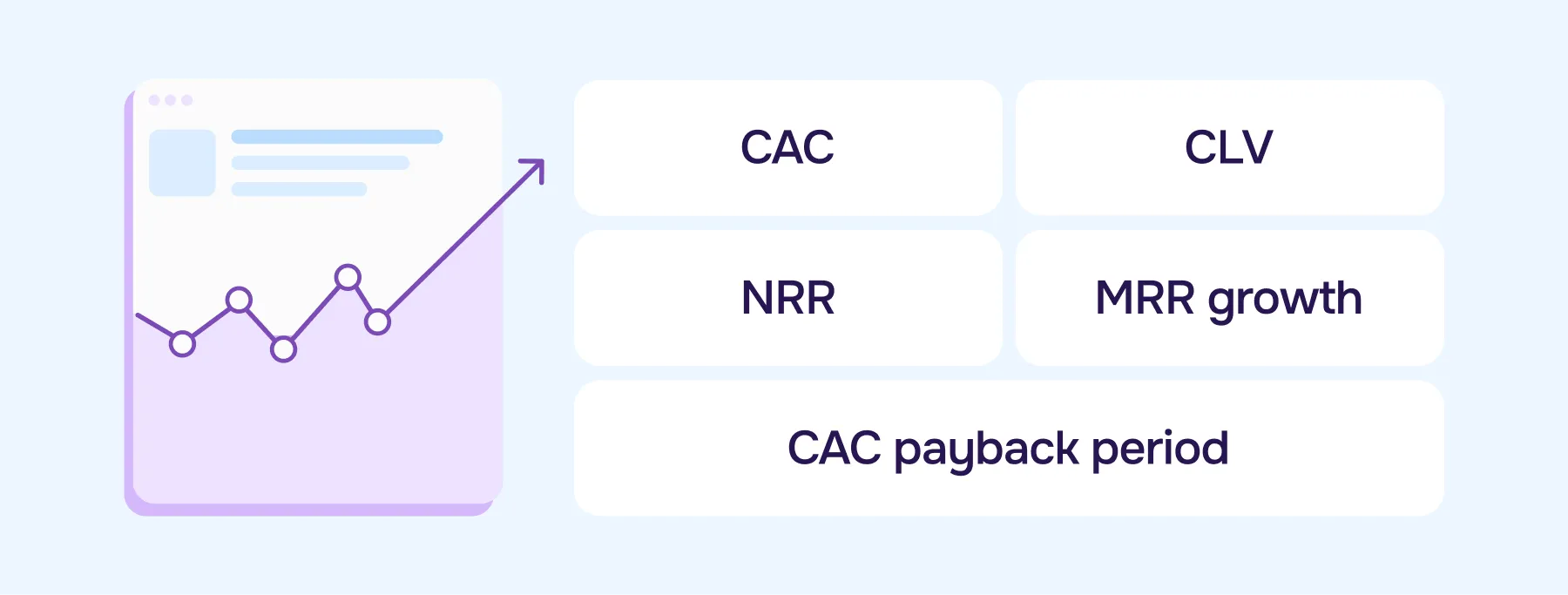B2B SaaS Marketing Metrics: KPIs You Must Track
Denis Yurchuk
July 14, 2025

Most B2B SaaS companies are obsessed with the wrong SaaS marketing metrics. We've seen it for years - founders celebrating a spike in marketing qualified leads like they just cracked product-market fit, meanwhile their customer acquisition cost (CAC) is quietly doubling in the background. Classic.
Here's the thing: vanity metrics are seductive. They make you feel good. Dashboards light up in green. Everyone smiles in the weekly meeting. But behind the scenes? You're spending more, converting less, and bleeding margin.
We've managed over $30M in paid media for SaaS brands at Aimers, and I've lost count of how many SaaS metrics dashboards. We noticed that they look impressive until you ask a simple question:
“Which of these marketing metrics actually predict revenue next quarter?”
Why B2B SaaS Marketing Metrics Will Destroy or Save Your Growth Strategy
Selling SaaS isn't transactional—it's relational. Long sales cycles, multiple decision-makers, complex onboarding. This isn't ecom.
So when your marketing KPIs go sideways and you don't notice? By the time you do notice, it's often too late.
Real story: We audited a Series A B2B SaaS company—they were hyped about 40% MoM MQL growth. Big smiles all around.
But when we dug into the SaaS marketing metrics:
- CAC had doubled
- Sales was converting 2% of those leads
- The pipeline was full of junk
They were celebrating noise. Meanwhile, the important SaaS metrics? Absolutely screaming. But no one was listening—the dashboard was too pretty.
Essential B2B SaaS Marketing KPIs Every Company Must Monitor
1. Customer Acquisition Cost (CAC)—The Real One
Not just ad spend divided by new users. I'm talking full sales and marketing costs:
- Sales salaries
- Tools and licenses
- SDR coffee habits
- Overhead
If you're not rolling all of it in, you're kidding yourself. And you'll over-invest in the wrong marketing channels.
We break CAC into:
- Blended CAC (everything)
- Paid CAC (ads + promos)
- Organic CAC (free… but not really)
Pro tip: organic traffic isn't free when you factor in the salaries of your SaaS marketing team, your SEO agency, and those 3 content tools you forgot you're still paying for.
2. Monthly Recurring Revenue (MRR) - But Smarter
Yes, everyone knows MRR is total monthly subscription revenue. Great.
But are you tracking MRR velocity?
- New MRR
- Expansion MRR
- Contraction MRR
- Churned MRR
You don't want growth from new users only. If no one's expanding and customer churn is rising, you're just refilling a leaky bucket.
3. Customer Lifetime Value (CLV)—Segment It or Scrap It
Averaging ARPU x lifespan might seem right, but it's fiction.
Your $3K/month enterprise customers from LinkedIn aren't the same as your $99/month self-serve signups from Google. Segment everything—by source, by plan, by behavior. That's where real marketing insights live.
SaaS Marketing Metrics That are Relevant for Acquisition
Everyone obsesses over top-of-funnel traffic. But the scary stuff hides deeper.
Fix the Funnel, Not Just the Homepage
Stop refreshing Google Analytics like it's your stock portfolio.
Website conversions don't tell you why leads aren't turning into revenue. We've seen clients driving decent traffic to landing pages that convert fine, but 80% of leads go nowhere after MQL.
That's where the gold is. Map your funnel like this:
.webp)
Find the drop-offs. That's where growth is hiding.
MQL vs. SQL: Let's Talk About the Lie
Marketing thinks leads are qualified. Sales disagrees. Spoiler: both are right.
If your MQL-to-SQL rate is under 25%, your definitions are broken. Either marketing is fluffing the numbers, or sales isn't aligned.
Fix the definitions. Then fix the lead quality.
Key SaaS Metrics That Reveal If Your Business Model Actually Works
1. ACV and Revenue Per Customer
Track this by acquisition channel. Your Google Ads leads might close smaller but faster. Your outbound enterprise deals? Higher ACV, slower velocity.
Don't just look at averages. Averages mislead.
2. Pipeline Velocity: How Fast Are You Closing?
.webp)
If this is slowing down, find what's broken:
Too many small deals?
Low win rate?
Sales dragging their feet?
Each answer means a different fix.
3. Net Revenue Expansion
This is your second engine. Your growth shouldn't depend solely on new leads.
110%+ net revenue expansion means your existing customers are paying you more over time. Less pressure on CAC, more stable B2B SaaS marketing.
Retention Metrics: The Brutal Truth About Your Business Health
All the CAC and MRR in the world mean nothing if you can't keep customers.
1. Churn Rate: Gross vs. Net
Gross churn = logos lost
Net churn = logos lost - revenue expansion
High gross churn with decent net? You're upgrading the good and losing the bad.
Track churn rate by cohort and source. Discounts bring churn. Always.
2. Net Revenue Retention (NRR)
The ultimate SaaS marketing KPI.
110%+ for mid-market
130%+ for enterprise
But NRR is a lagging metric. Watch leading indicators like:
- Product usage
- Support ticket volume
- Health scores
Advanced SaaS Marketing Metrics to Track (Once Basics Are Nailed)
Don't touch these until you've got your essential KPIs down. For teams ready to dive deeper into advanced SaaS marketing metrics, there's a whole world of granular insights waiting.
- Sales Cycle Length
Getting longer? Figure out why:
- Going upmarket? (good)
- Losing to competitors? (fix)
- Messaging mismatch? (fixable)
- Feature Adoption & Product-Led Growth
These are vital SaaS marketing metrics. High-adoption features → retention drivers. Low-adoption ones? Cut or fix.
Every product marketing team should track this.
- Marketing Attribution: Good Enough Is Good Enough
Use first-touch for top-of-funnel
Use multi-touch for customer journeys
Use revenue attribution to justify budget
Perfect doesn't exist. Just stay consistant.
SaaS Marketing Metrics Benchmarks (for Context, Not Worship)
These are directional, not commandments:
.webp)
Build a SaaS Metrics Dashboard You'll Actually Use
Don't try to track everything. You'll drown.
When developing your SaaS KPIs, start with the metrics you should be tracking:

Then add 1–2 new marketing KPIs per quarter. Watch trends, not monthly noise.
Every metric should lead to an action. If you don't know what you'd do when a number shifts, drop it.
If your dashboard is a mess and nothing makes sense, consider getting a professional PPC audit to identify what's actually driving results versus what's just noise.
For PPC campaigns specifically, this visual guide to essential SaaS KPIs breaks down exactly which metrics matter most for paid advertising performance.
Remember: the best B2B SaaS companies don't track more—they act on less. Want help fixing your metrics? Let's talk. No dashboards for dashboards' sake. Just clarity, growth, and the KPIs that matter.
FAQ
Q: What are the most important SaaS marketing metrics for early-stage startups?
A: Focus on the basics first: Customer Acquisition Cost (CAC), Monthly Recurring Revenue (MRR), Customer Lifetime Value (CLV), and churn rate. These give you the clearest picture of whether your growth is profitable or not.
Q: How often should I review my SaaS marketing KPIs?
A: At least monthly, but watch trends quarterly. One bad week doesn’t mean much, but three months of declining CAC payback is a red flag.
Q: What’s the difference between vanity metrics and actionable metrics?
A: Vanity metrics (like website traffic or social media likes) look nice but rarely correlate with revenue. Actionable metrics (like SQL-to-won rate or CAC) inform real decisions.
Q: Should my team use first-touch or multi-touch attribution?
A: Use both if possible. First touch helps understand where leads originate; multi-touch tells the full story of how they convert. The key is consistency, not perfection.
Q: When should I start segmenting CLV by customer cohort?
A: As soon as you have enough data. Segmenting by acquisition source, customer size, or industry can highlight wildly different outcomes that inform smarter marketing spend.
Q: What tools do I need to track these metrics?
A: At minimum, use Google Analytics, your CRM (like HubSpot or Salesforce), and a reporting layer (Looker, Databox, or even a solid spreadsheet). Make sure your attribution and funnel tracking are reliable.










